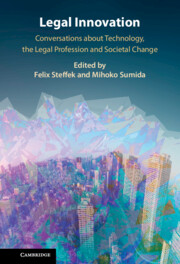This book is a compilation of the lectures and discussions on legal innovation held at Hitotsubashi University in the year 2021. All contributions were updated in 2022 (with some additions in 2023) and further texts were added. The lectures were not limited to the Faculty of Law but were open to students of other faculties. They were conducted online due to the COVID-19 pandemic. The lectures were part of a joint research project titled ‘Legal Systems and Artificial Intelligence’ between Hitotsubashi University in Tokyo and the University of Cambridge. Given the nature of this collaboration, the project also involved many lecturers from other countries, particularly the United Kingdom. The results of this project are reflected in this lecture series.
In the words of Professor Mihoko Sumida, who is one of the outstanding organisers of this lecture series as well as the aforementioned joint research project and who demonstrates exceptional conceptual abilities, ‘We want to tell the students, who will be the next generation, exactly how the world of “law” is changing, and we want to give them the opportunity to think about and explore the concept of “legal innovation” together, at a stage when the concept has not yet been properly established.’ It is strongly intended to prevent students and readers from turning into ‘great white sharks that have been washed up on the beach’. Even organisms that have been optimised for survival in a certain environment become helpless when the existing environment is completely changed. Accordingly, even though it is important to study law based on the current environment in depth, what is more important is to equip students with the ability to cope with any change in the environment. This awareness of the problem must have made Professor Sumida work hard to realise this lecture series.
With this in mind, the methodology of the lectures and the book was to expose students and readers directly to a variety of issues. Although many of these issues are based on new technologies (digitalisation, artificial intelligence, etc.), as Conversation 4 (‘What Can We Learn from the Okawa Elementary School Tsunami Litigation?’) clearly shows, legal innovation is not necessarily limited to technology in the narrow sense. Rather, legal innovation also includes the creation of new legal interpretations. In a sense, the book rejects the systematisation of legal innovation and confronts readers with the practice of various ‘live’ innovations, expecting them to develop their imagination and creativity. The question-and-answer sessions with the students reflected in the chapters, in which we see their bewilderment but also their joy at being confronted with new ‘knowledge’, are testimony to the success of this lecture series.
The contents of this book are, as mentioned earlier, extremely diverse. They include dispute resolution (Conversation 2), corporate governance (Conversation 5), law enforcement and financial regulation (Conversation 6), and the transformation of law firms (Conversation 7). The chapters provide a kind of ‘battlefield diary’ of the debaters who are at the forefront of their respective fields and who are trying to achieve innovation in the face of major environmental changes, particularly digitalisation. The readers will feel a sense of worry that they are becoming ‘great white sharks’ but also a sense of excitement at being on the frontline of innovation. The specific findings from Japan and the United Kingdom are useful, but what is more important is the methodology used by each of the commentators to confront the issues. Naturally, the methodologies vary from one commentator to another (e.g. in Conversation 5, Professor Sumida expresses some discomfort with the idea of ‘functional equivalence’ presented by Professor Kozuka). This, however, is not surprising, and the lack of a common methodology is in itself a characteristic of innovation. The reader has no choice but to develop their own methodology, with this book by their side.
Needless to say, the lectures on which this book is based are aimed at students, but the book itself is an essential read not only for students but also for anyone involved in ‘law’ in the broadest sense. Lawyers, judges, corporate lawyers, government officials and alternative dispute resolution (ADR) and other legal advisors stand to benefit from this book. They should first read the chapters on topics relevant to them and then expand their interests to include other areas that the book discusses. Additionally, we would like to encourage people in the sciences, such as data scientists, to pick up a copy of this book. We hope that many of them will enter the new professions discussed in Conversation 3 or become legal engineers who will support new law firms, as elaborated in Conversation 7.
Lastly, the part of the book that made the greatest impression on me was where, in Conversation 5, Mr Takuya Izumi of the Ministry of Economy, Trade and Industry (who also has a science background), quotes Heisenberg as reported by Professor Iwao Nakatani of Hitotsubashi University as follows:
[O]nly those revolutions in science will prove fruitful and beneficial whose instigators try to change as little as possible and limit themselves to the solution of a particular and clearly defined problem. Any attempt to make a clean sweep of everything or to change things quite arbitrarily leads to utter confusion.
As rightly captured by this quote, innovation is always based on the accumulated wisdom of our predecessors. Hence, traditional legal education in universities is extremely useful. At the same time, it is also important to pay attention to the finer points of practice, without which innovation is not possible. In this sense, the theme of Conversation 8, ‘Will Digitalisation Help the Five Billion People without Meaningful Access to Justice?’, is pertinent. This book will give all readers the opportunity to make such a contribution. This is why I recommend it to all those interested in the law and its innovation.

